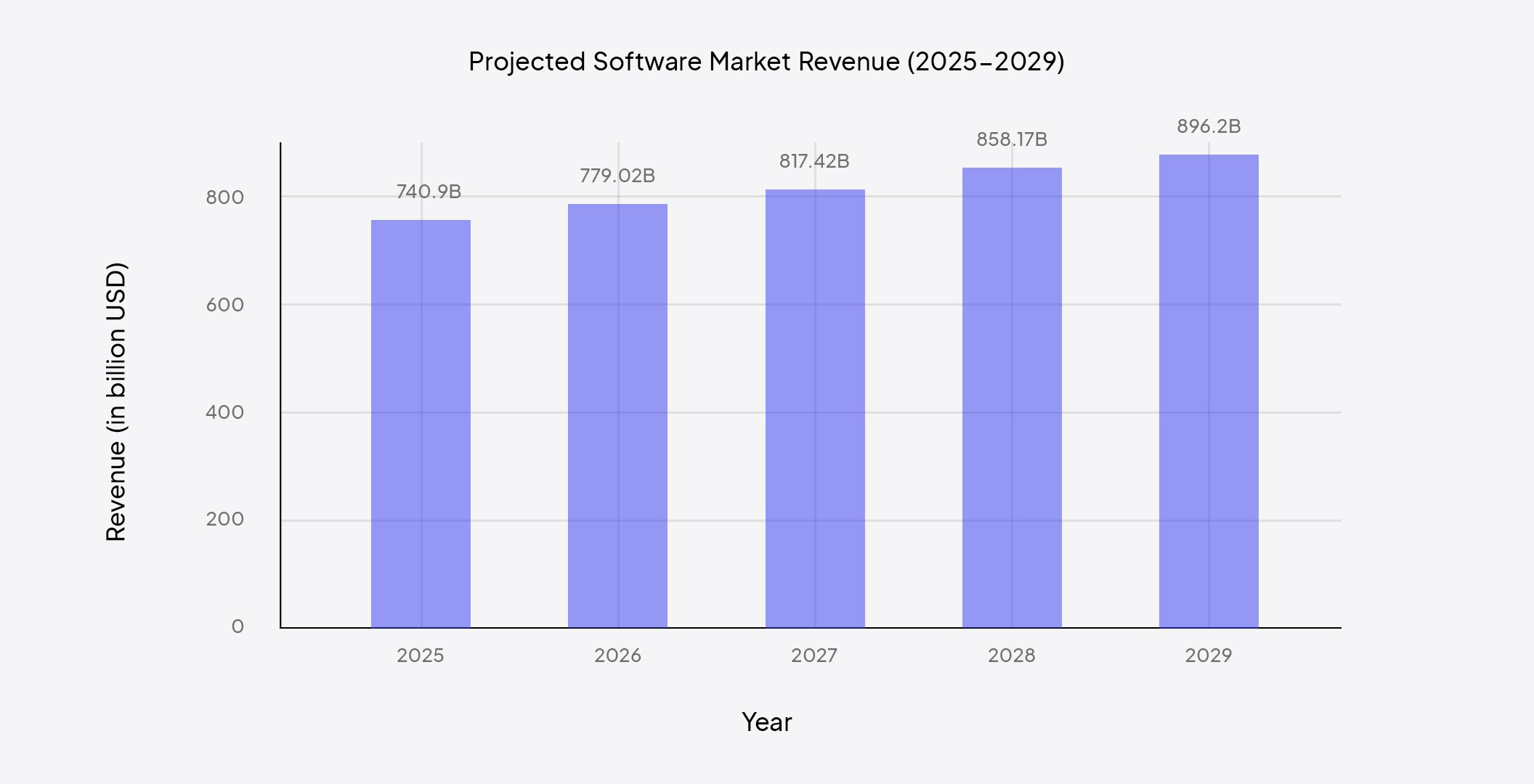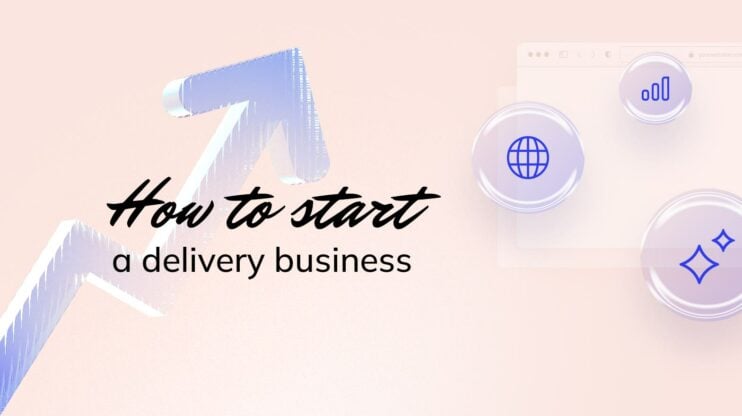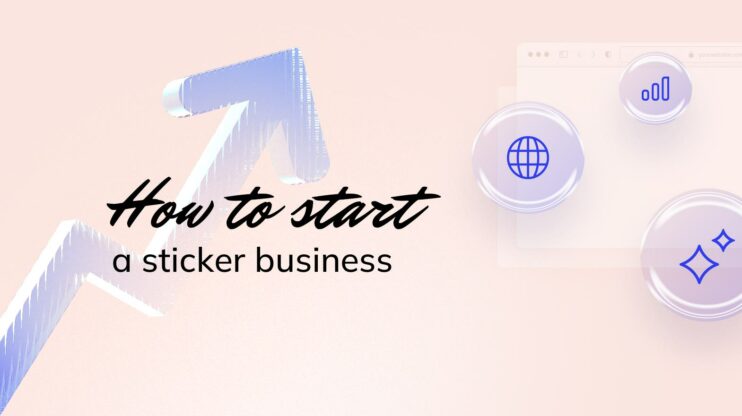AI is out in the market and it seems like “everyone” is building their own software. You are one of the tech enthusiasts, here to learn how to sell software online. AI has really made the lives of developers easier, with 92% of U.S.-based developers using AI coding tools both at work and outside of work.
Ok, coming back to selling software online; the market is experiencing rapid growth and transformation, giving numerous exciting opportunities for businesses. Big shifts are happening—subscription models are taking over, mobile apps are booming, and platforms like Amazon are more dominant than ever. These trends aren’t just shaping the landscape; they’re redefining how we buy, sell, and engage with brands.
I went through Statista and found that the software market was expected to hit around $740.9 billion by 2025. And the growth isn’t slowing down—it’s projected to climb at a steady 4.87% per year, reaching about $896.2 billion by 2029. In other words, the demand for software is skyrocketing, and the industry isn’t going to pause anytime soon. So, what are we waiting for? Let’s figure out how to sell software online!
Looking to sell online? Develop and launch your store with 10Web AI Ecommerce Website Builder.
Create your online store in minutes!
Selling software online vs. selling a SaaS solution
A friend of mine was thinking of writing software, and he had to choose between these two options: creating downloadable software that users install locally on their devices or launching a subscription-based SaaS (Software as a Service) solution accessed via the cloud. He said that the choice between these two is often compared to modes of transportation. Downloadable software is like purchasing a car; you invest upfront, and it’s your responsibility to maintain, repair, and operate it. While SaaS is like taking a cab; you pay for the service as needed, without concerns about maintenance or ownership.
If you’re looking for the easiest way to break into the software market, developing downloadable software is a good start. You build your application, make it available on your website or your GitHub account, and allow users to download and install it. This approach avoids the need to build a complex cloud infrastructure. That’s what my friend did, and now all he has to do is to release updates to keep the software running.
Downloadable software can also be an extension of an existing application, such as a plugin for WordPress. So, if there is an existing application you are passionate about, you may think of adding a missing feature to it, instead of building something from scratch.
Alternatively, building SaaS software brings more challenges. It requires creating a complex and often costly app infrastructure. You must ensure your software performs well in the cloud and that any downloadable components remain synchronized, even if they offer offline access. SaaS models typically charge a flat monthly, quarterly, or annual subscription fee. And, from what I have perceived; the subscription-based models are always much more profitable; you attract the customer once and they are yours for months or years.
Selling software online today
Selling software online is changing fast—blink, and you might miss the next big trend. It’s like upgrading your phone; just when you think you have the latest model, a new one comes out with features you didn’t even know you needed.
If you want to stay ahead in the market, you’ve got to keep up. So, let’s make sure you’re not stuck selling “flip phone” software in a smartphone world.
Trends to know to sell software online
The market is seeing a shift towards subscription-based models. SaaS is growing in popularity, providing users with frequent updates and support.
Another trend is the rise of mobile apps. Many software developers now focus on creating mobile-friendly versions of their products to serve the increasing number of mobile users.
Also, selling through marketplaces such as Amazon has become common. These platforms offer broader reach and established user trust, enabling quicker market entry.
Financial projections of the market
You shouldn’t enter a market without learning what’s going on financially. So, let’s discuss finance in the software-selling market. The online software market is on a serious growth streak. According to industry reports, we’re looking at a market worth around $896.2 billion—all thanks to the growing demand for digital solutions.
A huge chunk of this growth comes from SaaS, as more businesses shift to subscription and pay-per-use models. And let’s not forget the AI and machine learning boom—these technologies are shaping the future of software and opening doors to game-changing innovations. So, now is the right time to make a move in the market.
How to sell software online
You’ve likely realized that after building your software, the real challenge begins—selling it. (And that’s exactly why you’re here.)
Turns out, having great software isn’t enough—you need a strategy to sell it.
If you really want to have successful software sales, then you should start building your brand, understanding your market, and choosing the right platforms to get your product in front of the right people. Whether you’re launching your first software or scaling an existing one, this guide will walk you through everything—from market research to setting up your ecommerce site.
Create your brand
Your brand is how people remember you. It’s what makes your software stand out in a crowded market. In the ideal case, you’d map out every little detail of your brand before your product even launches. A catchy name, a sleek logo, the works. But things don’t always happen that way and this approach is very romanticized.
Most developers build the software, pick a platform, and start selling. The brand often comes later, once the product has carved out a place in the market. But if you’re someone who loves the idea of starting with a strong brand in place, let’s talk about how to make it work.
Start with a unique name, a logo that grabs attention, and a message that clearly explains what your software does and why it’s different. Keep this message consistent across your website, emails, and social media—consistency builds trust.
Your colors, fonts, and overall style should be instantly recognizable. And don’t just exist online—engage. Use social media to connect with potential customers, share valuable content, and build a community around your brand.
Need help coming up with the perfect name? Check out 10Web’s Business Name Generator. It will help you find unique business names and will provide logo ideas and available domain names—so you can claim yours instantly and start building your brand.
Map out your plan to sell software online
Before you start selling, get clear on what problem your software solves and why people should care. The best products don’t just exist—they make life easier, faster, or better for users.
Now, think big. Where do you want your software business to be in a few years? More importantly, how do you get there? Break your big vision into smaller, actionable steps so you’re not just dreaming, but executing.
Write it down. A clear vision keeps you focused, especially when things get chaotic. And if you have a team, share it! When everyone is on the same page; working toward the same goal is when real progress happens.
Research the market
If you want to sell software successfully, you need to know who you’re selling to. Start by identifying your ideal customers—who are they? What do they do? What challenges do they face? The more you understand their needs, the better product you can build for them.
Next, scope out the competition. See what they’re doing well and, more importantly, where they’re falling short. Those gaps are your opportunity to stand out.
Put guessing aside and get real data. Use surveys, online forums, and social media to see what people are looking for. The insights you gather will help you fine-tune your software’s features, pricing, and marketing strategy so you’re always a step ahead.
Some stats for you
- The global software market is expected to grow from $656.10 billion in 2024 to $1,497.10 billion by 2034, with a compound annual growth rate (CAGR) of 9.6%.
- The global Software as a Service (SaaS) market size was valued at $261.15 billion in 2022 and is expected to grow at a CAGR of 13.7% from 2023 to 2030.
- Within the software market, the Enterprise Software segment is expected to dominate, with a projected market volume of $400.4 billion by 2029.
- The United States is expected to generate the highest revenue in the software market, leading the global landscape.
Choose a platform for selling software online
Your sales platform is your storefront, your cashier, and your security system all in one. It takes a few seconds for a customer to stay or leave your store. It’s about the look, feel and the convenience it provides.
First, think about the software you’re selling and what pricing model works best for you. Make sure the platform you choose can handle that with ease.
Next, consider ease of use and scalability. Platforms like 10Web make life easier with automated web hosting, domain registration, website creation, and more–all in one place. Next, I will show you how to build a professional website with the platform.
Also, don’t forget the essentials; secure payments, reliable customer support, and strong data protection. An easy, safe experience keeps customers happy and builds trust, which means more sales in the long run.
Create an ecommerce website with 10Web
This is going to be your favorite part; creating a website for your software. 10Web’s AI Website Builder makes building an ecommerce website easy. Follow these simple steps:
- Visit AI Ecommerce Website Builder and select Generate your Website.
- Select the option to Create a new website with AI.
- Select the online store option to enable ecommerce functionality.
- Enter your business type.
- Answer a few questions about your business.
- Tell the AI about your first few products and categories, or adjust the pre-generated details.
- Let AI generate tailored content and images for you․
- Customize the content and images to match your brand with the 10Web Builder.
Once your generated store is complete, you can manage everything from the 10Web dashboard’s Ecommerce section.
- Add and manage your software: You can add, edit, and organize your software for sale at Ecommerce > Products.
- Configure store settings: Set up sales tax, location, currency, and more.
- Manage payment methods: Enable and configure payment gateways like PayPal and Stripe.
- Customer and order management: Manage customer accounts, orders, and communications with built-in WooCommerce tools.
The 10Web dashboard also provides easy-to-use features and tools for:
- Optimizing your site’s performance.
- Monitoring sales, user behavior, and traffic.
- Regular backups and built-in security.
You can take advantage of features like product description generation, product page customization, and content editing with AI. This helps you create a professional-looking digital products site without needing advanced technical skills.
To ensure your website is mobile-responsive, 10Web automatically optimizes your site for mobile devices, giving your customers an easy browsing experience.
Marketing & customer engagement: How to sell more
Building great software is just half the battle, getting people to notice and trust your product is the other half. A great marketing strategy and strong customer engagement turn visitors into buyers and buyers into loyal users. Here’s what you need to focus on:
Get your software in front of the right people
- Social media: Use platforms like Facebook, Instagram, LinkedIn, and TikTok to share updates, demos, and user success stories.
- Email marketing: Keep your audience engaged with updates, exclusive offers, and valuable insights.
- SEO & blogging: Write helpful, SEO-optimized content to drive organic traffic and establish authority.
- Third-party reviews: Get listed on platforms like G2, GetApp, and Capterra—social proof builds trust!
- Customer support & chatbots: Offer 24/7 support and automate quick replies with chatbots.
The scope of marketing will depend on your goals and priorities. Maybe you want to have a blog and spread the word about your product more, maybe you just want to silently deliver it in the market. Whatever you choose, the online space gives us all tools and resources needed for success.
Conclusion
The software market is booming, AI is making development easier, and trends like SaaS and mobile apps are shaping the future. With billions in projected growth, there’s never been a better time to jump in.
We’ve covered everything from choosing the right business model to setting up your ecommerce site and marketing your software effectively. Now understand your market, build a strong brand, pick the right platform, and engage your audience. It’s your turn.
FAQ
Where is the best place to sell your software?
How do you sell software successfully?
Is it legal to sell software?
Is a website necessary for selling software?
Do I need to form a company?
How to market effectively?
Should I offer a free trial?
Looking to sell online? Develop and launch your store with 10Web AI Ecommerce Website Builder.
Create your online store in minutes!














